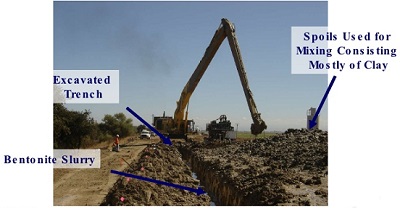 |
| Bentonite slurry to protect groundwater from contaminants |
Given his clearly nonexistent familiarity with bentonite (or, for that matter, slurries), Blackmon attempted to define the word right up front; and did a lousy job:
"Bentonite is a useful material in the creation of slurry walls, commonly used to divert the flow of groundwater in urban areas... Bentonite is a clay phyllosilicate, usually found in combination with other materials and metals..."
Well, actually, he didn't define bentonite, whether it's a "useful material" or not. In the first place, while slurry walls are sort of "commonly used to divert the flow of groundwater in urban areas"; they're also used to protect groundwater from contaminants. In the second place, "clay phyllosilicate" is redundant: all clays are phyllosilicates, and saying that the mineral is "found in combination with other materials and metals" is mere filler because Blackmon was too lazy to look up the source of the stuff. Bentonite is the weathered volcanic ash, and it's mined like many other natural resources.
Blackmon finished, in his "considerations" section, by explaining that
Once again our researchers have caught a scientific illiterate spreading half-baked misinformation. Blackmon's weak grasp of not just the methods and purpose of bentonite slurry usage but also his complete failure to address the reason why this "useful material" works at all is more than enough reason for us to give him his second Dumbass of the Day award.
¹ The original has been deleted by Leaf Group, but can still be accessed using the Wayback machine at archive.org. Its URL was ehow.com/facts_7209223_bentonite-slurry_.html
copyright © 2016-2021 scmrak
SI - MINERALS
Blackmon went on to "explain" that"Bentonite slurry is primarily used to create slurry walls that impede the flow of groundwater. These walls provide their own counterweight by exerting hydraulic pressure against their support structures."Again, utter bullshit. The most common use of bentonite slurry is in drilling muds (which is why Freddy glommed onto this topic: his self-described expertise in fracking and horizontal drilling). Further, such walls don't have "support structures" because they are merely thick coatings of impermeable clay on the surface of a trench or pit to prevent contaminants from migrating out or groundwater from flowing in. The "counterweight" bull? Pure dumbassery. |
Blackmon finished, in his "considerations" section, by explaining that
"The Portland Cement Association recommends combining the bentonite slurry with cement and other materials in certain cases. This helps the slurry wall maintain a low level of permeability and withstand chemical erosion."Well no, Freddy, the reason for mixing cement (and "other materials") with bentonite is to make a hardened wall: a bentonite slurry wall is little more than dried mud. The low permeability is a function of the swelling clays (smectites) in the bentonite itself, and has nothing at all to do with mixing the stuff with cement. Moron.
Once again our researchers have caught a scientific illiterate spreading half-baked misinformation. Blackmon's weak grasp of not just the methods and purpose of bentonite slurry usage but also his complete failure to address the reason why this "useful material" works at all is more than enough reason for us to give him his second Dumbass of the Day award.
¹ The original has been deleted by Leaf Group, but can still be accessed using the Wayback machine at archive.org. Its URL was ehow.com/facts_7209223_bentonite-slurry_.html
copyright © 2016-2021 scmrak
No comments:
Post a Comment